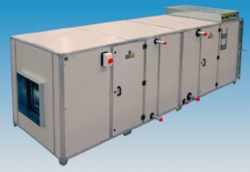Co-operation between air handling manufacturers, contractors and consultants has the potential to reduce costs and wastage as well as delivering a better solution for end users, says Joe Wieckowski
In Today's competitive environment, manufacturers are routinely being asked to re-submit tenders in a bid to reduce costs and essentially give more for less. Smaller margins and demands for faster turnarounds ensure that manufacturers have little room to manoeuvre. Although the goal is to deliver the best solution at the best price, many projects end up being price-driven and the best specification is not always selected. This costs the UK millions in terms of wasted resources, man hours and bureaucracy.
The effects are cumulative and far reaching. Project management can determine the end result. Unless all parties involved - contractors, consultants, manufacturers and customers - work together from the outset, a well-engineered and cost effective solution is difficult to achieve.
Contractors try to complete a job at minimal costs, but this can conflict with what is required. This is such a familiar scenario that health estate managers, for example, will use the Health Technical memorandum (HTM) guidelines to dictate what should be supplied. The HTM does not give explicit advice, but provides recommendations on the design, installation and operation of specialised building and engineering technologies used in the delivery of healthcare.
Operating theatres require a high specification whereas wards and administrative offices require less. But, in the current climate, hospitals have to be as flexible as possible and maximise efficiencies.
A non-critical area could, in the future, become a critical area and the health estate manager has to plan for any future internal changes from the outset. Closer co-operation throughout the supply chain could help achieve a more efficient and cost-effective solution.
Problems invariably arise at the start of the quoting process. Ideally, projects should go out to three manufacturers, but all too often it can be as many as five or more.
Often two sets of specifications are supplied, a generic one which cites standard requirements of compliancy which can run to 500 pages or more and a schedule of equipment specific to the job which states exactly what is required.
It is at this point that contractors will ask if manufacturers are fully compliant, even if some elements are not applicable. The horse trading begins, with prices being driven down and price is invariably king.
Repeatedly re-quoting for a project is time consuming, expensive and wasteful. Running regular 'beauty contests' with too many manufacturers setting out their stall and then repeatedly asking them to re-submit tenders with revised schedules and pricing is a waste of everyone's time.

This has led to some companies proposing the establishment of 'trading agreements' to simplify the process and lay down a road map that will see a reduction in the numbers involved in the supply chain. Working with fewer selected companies should help speed the process up and open up new channels of negotiation, and go some way to involving manufacturers earlier in projects so that they can offer full technical and project support from start to finish.
Manufacturers are, after all, best placed to offer advice on specifications, reliability, consistent performance and longevity, all key considerations that can affect the end result. By engaging us and making us part of the team, wider issues and parameters can be addressed and designed in.
There will always be projects that are purely price driven and these will certainly keep the company accountant happy, but if the spec falls far short of what's really required there aren't really any savings.
Co-operation and communication are essential between suppliers, contractors, consultants and customers. The amount of time and man hours saved will itself help ensure that costs are controlled and margins protected. The result will be a better engineered and more cost-effective solution.
// The author is general sales manager of Colman Moducel //